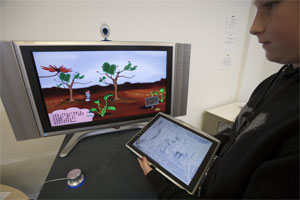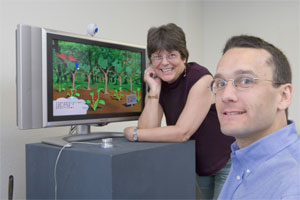EcoRaft Sows Seeds of Restoration at UC Irvine and Beyond
By Fran Tardiff
July 6, 2006 --More than 80 percent of lush Costa Rican rainforests have been chain-sawed and bulldozed for pasture and farmland. Exposed to rain, the rich topsoil eroded, vast areas lie abandoned and useless to farmers – yet they’re far from useless to Calit2 affiliates Bill Tomlinson and F. Lynn Carpenter.
They’ve employed the tropical environment in their EcoRaft project to model a lesson in restoration ecology. Incorporating new technology developed at Calit2, the engaging, interactive game focuses on kids 8 to 12 years old.
|
“While having fun playing the game, they’re learning basic rules of an ecosystem; namely, that destroying a habitat is easy. Restoring it, while an uphill battle, is still possible,” says Tomlinson, assistant professor of informatics and drama.
Collaboration Breeds Education
His collaboration with Carpenter, professor of ecology and evolutionary biology, has created a way of transferring computer-generated plants and animals from one virtual habitat to another. In EcoRaft, three desktop computers are virtual islands. A mobile tablet PC is the “raft” on which plant and animal species “float.” With raft in hand, the child picks up a hummingbird, a coral tree seed or other plant from a healthy, diverse environment and carries it to an island where habitat has been destroyed. A program, written in Java and C++, works with infrared sensors to enable the animated object to “jump” from healthy island to raft to barren land. Youngsters working together can repopulate the devastated island and help it blossom into a thriving rainforest.
The unique, multi-device game lets kids break the plane of the computer screen to interact with the environment and other people in ways both exciting and loaded with potential. About 2,500 people have seen EcoRaft so far. Responses have ranged from “Wow, that’s cool,” by kids who tried it in the Calit2 lab and at Santa Ana ’s Discovery Science Center , to nods of approval from grownups at the Siggraph 2005 exhibit in Los Angeles . The next step is to install permanent exhibits at the Discovery Science Center and similar sites around the country. Tomlinson sees EcoRaft as a powerful educational tool, part of a comprehensive lesson plan teachers can build around a museum field trip.
|
It also could be used to teach about other ecosystems on a more sophisticated level. Tomlinson and his team of graduate and undergraduate students are working on an infrastructure that accommodates new content for this kind of platform. And a downloadable version of the game will soon be available for play on home computers.
Repairing the Damage
“Most people don’t know about restoration. Yet they have the feeling that something’s not quite right with the natural world," says Carpenter, an expert in hummingbirds. Her research in Costa Rica restoring tropical forests and soils led to her role as ecological consultant for EcoRaft. She has lived with the vibrant hues and sounds of the tropical forest. She knows how hummingbirds fly, and which plants must grow first to support other species, all nuances of the interactive EcoRaft game that make it come alive.
Restoration ecology grew out of the need to repair the heavy metal slag heaps left after mining. Now it’s the study of how a destroyed habitat returns to biodiversity and how human intervention can help by jumpstarting the succession process. Restoration is most necessary where human activity – farming, fishing, mining, road building – has changed the whole ecological function of an area, Carpenter explains. Costa Rica is only one trouble spot. “The Amazon has the largest tract of uncut rainforest, but it’s going fast. Great Britain has only 1 percent of its forests left, and the U.S. is down to about 10 percent of its original forests. Many people are in denial. Others who realize the enormity of the problem go from discouraged to depressed to paralyzed. They think it’s hopeless, so they continue their destructive consuming behavior,” adds Carpenter, who believes EcoRaft can be a positive way of cultivating hope and cooperation, of getting young people to skip the paralysis stage and go directly to activism.
A Project Blossoms
The researchers’ common hope of repairing damaged environments through education is one reason EcoRaft sprouted at UCI. Calit2 is another. “They provided the lab space. And by its nature Calit2 encourages cross-disciplinary collaboration; it gave me a reason to call Lynn to see if we could combine our interests,” says Tomlinson. For similar reasons, EcoRaft has attracted funding from a host of sources: an $80,000 Calit2 Nicholas Foundation Prize for Cross-Disciplinary Research, the Emulex Corp., the Donald Bren School of Information and Computer Sciences, and Claire Trevor School of the Arts.
With a reminder that “it all starts with the kids,” Tomlinson opens an online video of youngsters enjoying the game. “Children are a pathway to new ideas within a family. Parents want to be seen as valuing and acting on the principles of their children.” So as EcoRaft flourishes around the country, it will disperse the seeds for a budding generation of restoration ecologists.
Video available at: http://www.ics.uci.edu/~wmt/movies/EcoRaftUCI.mov.
Related Projects
Game Culture and Technology Lab



